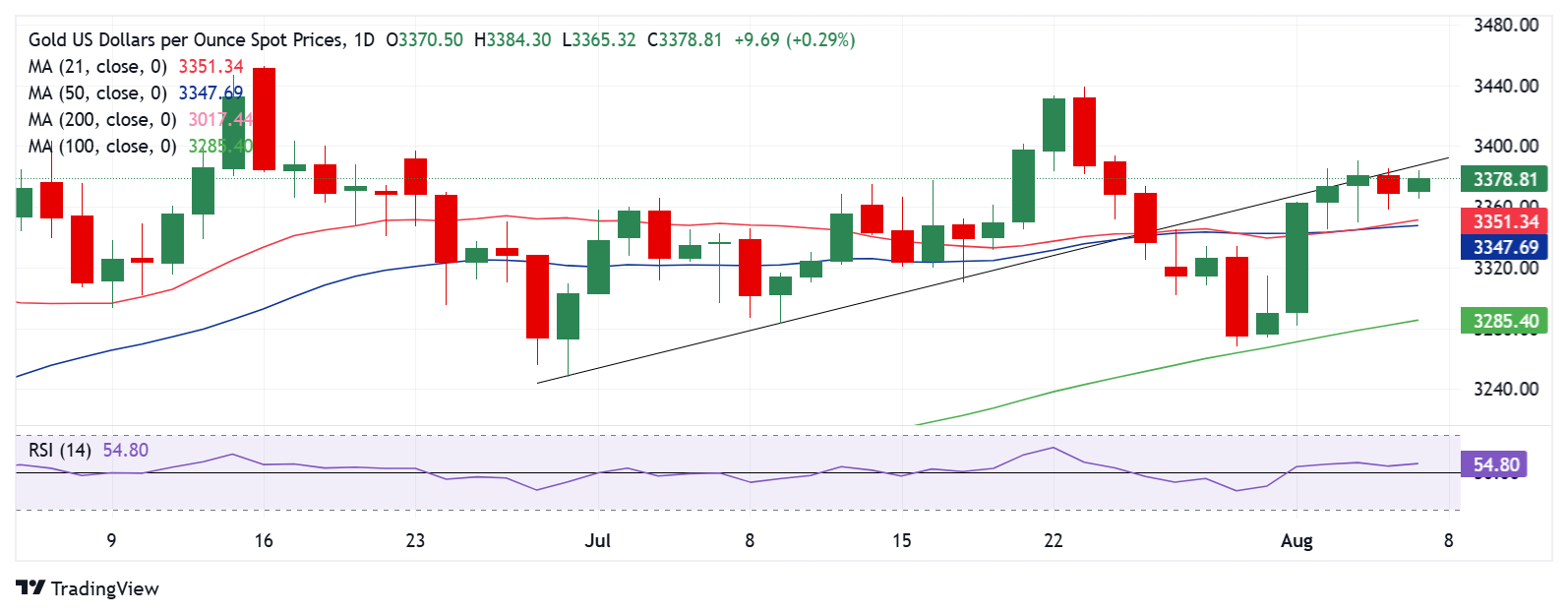
- Gold price is back on bids early Thursday, following Wednesday’s brief pullback from near eight-day highs.
- The US Dollar remains vulnerable amid increased Fed rate cut bets, US economic woes.
- Technically, upside risks remain in place for Gold price, with eyes on a sustained move above $3,390.
Gold price is back on the bids early Thursday, resuming its recent recovery rally after a temporary pullback seen on Wednesday.
Gold price awaits US data amid Fed and trade concerns
Amidst ongoing trade headlines and the wait for the announcements of the US Federal Reserve (Fed) appointees to replace Fed Governor Adriana Kugler and Chairman Jerome Powell, Gold price looks forward to the mid-tier US Jobless Claims and preliminary second-quarter Unit Labor Cost data for fresh hints on the state of the US labor market.
The July labor data disappointment and a slowdown in the American services sector have already intensified concerns over the US economic prospects, doubling down on expectations that the Fed will lower interest rates in September.
This dovish narrative provides fresh support to Gold buyers, while they also capitalize on renewed haven demand due to the latest tariff threats from US President Donald Trump on its Asian trading partners.
Citing a White House official, a Japanese newspaper, Asahi, reported that Trump could impose an additional 15% tariff on all Japanese imports.
Meanwhile, Trump’s trade adviser, Peter Navarro, warned early Thursday of extra China tariffs over Russian oil imports.
This comes after the US president imposed an additional 25% tariff on goods from India on Wednesday, with the executive order mentioning that India directly or indirectly imported Russian oil.
Gold price technical analysis: Daily chart

The short-term technical outlook for Gold price remains constructive amid a Bull Cross in play and a bullish daily Relative Strength Index (RSI).
The leading indicator points higher above the midline, currently near 55, suggesting that additional upside remains in the offing.
Meanwhile, the 21-day closed above the 50-day SMA on Tuesday, confirming a Bull Cross.
If the buying momentum gathers strength, Gold price could see a sustained break above the rising trendline support-turned-resistance at $3,387, close to the eight-day high of $3,390.
The next healthy resistance levels are seen at the $3,400 threshold and the $3,440 static barrier, followed by the June 16 high of $3,453.
Alternatively, strong support is placed at the 21-day SMA and 50-day SMA confluence near $3,350. Acceptance below that level will unleash additional downside toward the $3,300 round figure. Deeper declines will challenge the 100-day SMA at $3,282.
Tariffs FAQs
Tariffs are customs duties levied on certain merchandise imports or a category of products. Tariffs are designed to help local producers and manufacturers be more competitive in the market by providing a price advantage over similar goods that can be imported. Tariffs are widely used as tools of protectionism, along with trade barriers and import quotas.
Although tariffs and taxes both generate government revenue to fund public goods and services, they have several distinctions. Tariffs are prepaid at the port of entry, while taxes are paid at the time of purchase. Taxes are imposed on individual taxpayers and businesses, while tariffs are paid by importers.
There are two schools of thought among economists regarding the usage of tariffs. While some argue that tariffs are necessary to protect domestic industries and address trade imbalances, others see them as a harmful tool that could potentially drive prices higher over the long term and lead to a damaging trade war by encouraging tit-for-tat tariffs.
During the run-up to the presidential election in November 2024, Donald Trump made it clear that he intends to use tariffs to support the US economy and American producers. In 2024, Mexico, China and Canada accounted for 42% of total US imports. In this period, Mexico stood out as the top exporter with $466.6 billion, according to the US Census Bureau. Hence, Trump wants to focus on these three nations when imposing tariffs. He also plans to use the revenue generated through tariffs to lower personal income taxes.
Information on these pages contains forward-looking statements that involve risks and uncertainties. Markets and instruments profiled on this page are for informational purposes only and should not in any way come across as a recommendation to buy or sell in these assets. You should do your own thorough research before making any investment decisions. FXStreet does not in any way guarantee that this information is free from mistakes, errors, or material misstatements. It also does not guarantee that this information is of a timely nature. Investing in Open Markets involves a great deal of risk, including the loss of all or a portion of your investment, as well as emotional distress. All risks, losses and costs associated with investing, including total loss of principal, are your responsibility. The views and opinions expressed in this article are those of the authors and do not necessarily reflect the official policy or position of FXStreet nor its advertisers. The author will not be held responsible for information that is found at the end of links posted on this page.
If not otherwise explicitly mentioned in the body of the article, at the time of writing, the author has no position in any stock mentioned in this article and no business relationship with any company mentioned. The author has not received compensation for writing this article, other than from FXStreet.
FXStreet and the author do not provide personalized recommendations. The author makes no representations as to the accuracy, completeness, or suitability of this information. FXStreet and the author will not be liable for any errors, omissions or any losses, injuries or damages arising from this information and its display or use. Errors and omissions excepted.
The author and FXStreet are not registered investment advisors and nothing in this article is intended to be investment advice.







